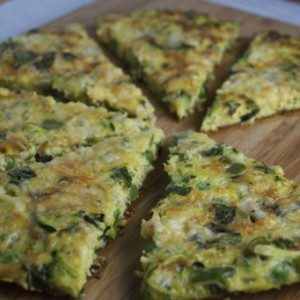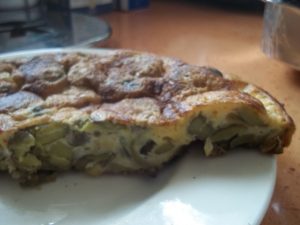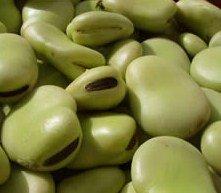
Frittata with Fresh Fava Beans
(Frittata con Fave Fresche - Frocia chi Favi)
Italy is the world’s biggest produce of fava beans. In Sicily and in all southern Italian regions fava is a largely cultivated bean; in season is consummated fresh and cooked in a variety of ways or dried, stored and used in the cold months. The fava beans are planted in the cold season and harvested from April to the end of June. Fava are cultivated in many varieties, some for human consumption, others for fodder. Fava beans are grown in large quantity in Castroville, California by the Ocean Mist Farms and available in supermarkets from May to November.
Fava beans are much sought-after in low-calorie diets, and for other medicinal properties. In fact because of the variety of minerals and vitamins content, fava are beneficial for anemic people, also a tea made from the fava’s dry leaves is an excellent diuretic; what’s more because of the high content of levodopa, the fava beans are a natural remedy to alleviate the effects of the Parkinson Disease. Fava beans are versatile: they can be eaten raw with pecorino cheese as a snack or as an appetizer, as a contorno, that is a side dish, in soups, to prepare the Sicilian macco, with pasta, or with eggs to make a delicious frittata. The frocia or frittata with fava is often cooked in season all over Sicily, especially in rural zones, where fava beans are abundant and easily available.


- Serving Size4-5
- Eggs, Introduction and Recipes
Ingredients
The Fave
- 2 lb. fresh fava beans in pods
4 scallions. Washed, skin, tips and ends removed; green and white parts chopped.
2 tablespoons of olive oil
salt
The Frittata
- 4 tablespoons of olive oil divided
8 eggs
Method
Instructions
PREPARING THE FAVA
Remove fava from their pods. Bring a medium size pot of water to a boil; add a little salt and plunge beans into boiling water. Cook for 5 minutes then using a slotted spoon, transfer into a bowl with cold water. Drain beans, then gently peel, discard skin and set on the side. At a high heat, in a non stick frying skillet, heat 2 tablespoons of olive oil and add the scallions. Sauté for 2 minutes, then add the fava beans and cook for an additional 5 minutes, turning frequently. Set on the side.
THE COOKING
In a large bowl, lightly beat 5 eggs; fold in ½ of the cheese and ½ of the breadcrumbs. Add the parsley, salt, and pepper. In the previously used skillet, heat 2 tablespoons of oil and swirl the oil in the pan. When the oil is hot, remove from the heat, and slowly pour the egg mixture into it. Return to the heat and cook for 3 minutes at a medium heat. Continue cooking the frittata covered at a low heat from 7 to 10 minutes, shaking and tilting the skillet often to prevent it from sticking to the bottom, and occasionally rotate a spatula around the edge of the skillet preventing the frittata from sticking to the sides. When the bottom of the frittata is cooked, cover it with a dish the same size of the skillet; turn it upside down onto the plate and over a dish to collect eventual drippings. Set on the side. In the same large bowl, lightly beat the 3 eggs, put and fold in the remaining cheese and breadcrumbs, add salt and pepper to taste. Heat the remaining tablespoons of oil, until it starts to smoke. Remove the skillet from the heat, and pour in the egg mixture. Cook for 1 minute and sprinkle over the sautéed fava beans; then slowly slide in the frittata into the skillet, uncooked side down; reduce the heat to a medium and cook for an additional 5 to 10 minutes, or until the bottom of the egg mixture is set. Transfer to a serving plate, cool it briefly, cut into wedges and dish it up as an appetizer or if served as main course, add a salad, fresh Italian bread and a young Californian Chablis wine to make a complete dinner.
